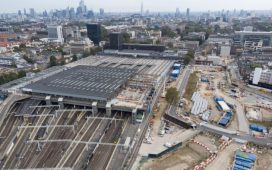London property owners have won a landmark privacy case over the use of the Tate Modern’s viewing platform that has allowed “hundreds of thousands” of people to gaze into their homes.
The UK Supreme Court on Wednesday ruled in favour of five occupants of Neo Bankside, a luxury residential block with glass walls located next to the popular tourist attraction.
The flat owners first brought legal action in 2017 against the board of trustees of the Tate gallery, seeking to stop “very significant” numbers of visitors from peering into their homes from the platform that opened in 2016.
This action failed after a judge ruled in 2019 that the Tate’s use of its top floor as a viewing gallery was reasonable and residents had exposed themselves to view by choosing to live in homes with glass walls.
At the time, the judge suggested that residents protect their privacy by installing net curtains or drawing their blinds during the day. A further appeal by the residents was dismissed by the Court of Appeal in 2020.
On Wednesday, the UK’s highest court ruled by a majority in favour of the residents and found that the Tate’s viewing gallery was not a “normal” use of its land and was a “legal nuisance” to the homeowners.
Lawyers said the ruling was significant because the Supreme Court concluded that visual intrusion was capable of being a legal nuisance.
The common law of nuisance is designed to protect homeowners from the activities that unduly interfere with the use of their homes, such as a neighbour playing loud music late at night.
Greg Simms, legal director in Addleshaw Goddard’s real estate disputes team, said the ruling that overlooking can be considered a legal nuisance “is likely to worry developers”.
However, he added it was unlikely “ordinary” residential and commercial developments would be affected because most were not making “abnormal” use of their land.
The court heard that the platform — visited by more than roughly 500,000 people in 2019 — had allowed the public to take photographs, use binoculars to see inside their flats and post pictures online. One resident described the “relentless intrusion” of living there.
Lord Justice George Leggatt, said in his ruling: “It is not difficult to imagine how oppressive living in such circumstances would feel for any ordinary person — much like being on display in a zoo.”
The five residents bought their luxury flats in 2013 and 2014. Other units in the development are listed for between £775,000 and £3.4mn.
The flat owners had applied for an injunction requiring the gallery to cordon off parts of the platforms or to erect screening to prevent the public from peering into their homes.
The case will now be sent back to the High Court for a judge to decide a solution for the flat owners. The Tate’s viewing gallery has been closed since the Covid-19 pandemic started in 2020.
Natasha Rees, senior partner at Forsters and the residents’ lead lawyer, said: “Our clients are both pleased and relieved that nearly six years after they began their claim the Supreme Court has now found in their favour.
“[They] now look forward to working with the Tate as valued neighbours to find a practical solution [that] protects all of their interests.”
Tate Modern said: “We thank the Supreme Court for their careful consideration of this matter . . . As the case is ongoing we cannot comment further.”
Letter in response to this article:
Flat owners should not get hopes up after Tate ruling / From Lisa Barge, Head of Real Estate Litigation, Eversheds Sutherland, Birmingham, UK











